Flash starts and wins: the future of SSD
The future belongs to flash drives (SSDs): they can provide much higher data transfer speeds than traditional hard drives (HDDs), and at the same time become relatively inexpensive. The widespread adoption of SSDs can lead to significant changes in the architecture of data centers and computing systems.
Servers and storage systems with SSD flash drives allow you to solve the most demanding tasks, such as searching in large databases, online transaction processing, business analytics, big data processing and large-scale virtualization. SSDs have every chance of significantly crowding out HDDs in servers and storage systems, becoming a key component of hyperconverged systems. By 2020, a 40TB flash drive may appear, the problem of SSD durability has been practically solved.

Erasing and writing to NAND flash memory leads to its gradual degradation at the level of individual cells, but if NAND consumer drives are designed for 3000-10000 write operations, then modern enterprise-class flash drives can withstand up to 100,000 cycles.
Flash memory helps you work with data more efficiently and store it. SSDs are increasingly being used to store not only “hot”, but also “cold” data.
Hard drives have been around for more than 60 years since IBM first introduced them in 1956. The first disk was huge and could store only 3.75 megabytes, and cost 300,000 dollars in terms of today's exchange rate.

1956 IBM 350 Disk Storage System The
350 Disk Storage System was the primary component of the IBM 305 RAMAC (Random Access Method of Accounting and Control). It consisted of 40 plates and a double read / write head, which moved up and down the stack of magnetic disks.
Since then, the main mechanism of the hard drive, its design has remained unchanged, although it has undergone significant revision. HDD uses the principle of magnetization to store data on a rotating disk. The read / write head “floats” above the magnetic surface of the disc. The higher the rotation speed, the faster the hard drive can work. Typical household HDDs today run at 5400 or 7200 rpm, and some server drives have even higher speeds of 10-15K rpm.

HDD Components HDD
plates are magnetically sensitive, and data is recorded when the magnetic head moves over the surface of a rotating disk. It quickly inverts the magnetization of magnetic domains, changing it to 1 or 0 in binary code. The main and perhaps the only advantage of the hard drive today is that it provides inexpensive storage of a large amount of data - 10-12 TB per disk.
The recording density and HDD rotation speed continue to grow. And if you compare the prices of ordinary hard drives and SSDs, then for solid state drives the cost of storing a data unit is about 3-5 times higher. Therefore, conventional hard drives remain the most economical way to store. According to IDC, today they account for more than 90% of the supply of enterprise-class drives, but by 2025 SSDs will make up almost 20% of the supply.

IDC forecast: how the ratio of HDD and SSD in the supply of corporate drives will change.
What are the best hard drive usage scenarios?
In almost all other tasks, the advantage is in flash memory.
In fact, SSDs also have a long history. The first semiconductor memory device compatible with the hard disk interface appeared back in 1978. This is StorageTek 4305.
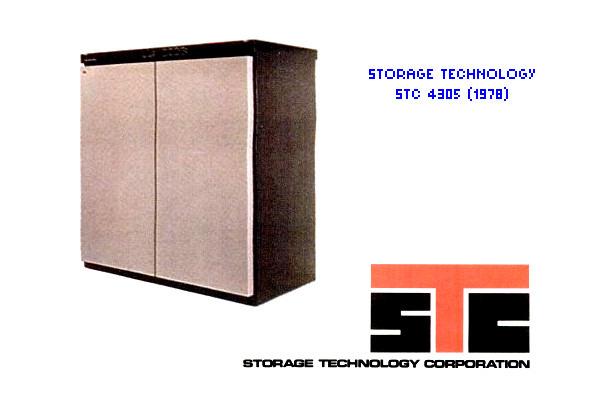
Storage Technology 4305 - 45 MB SSD sample of 1978.
StorageTek was designed for IBM mainframes. The STC 4305 was seven times faster than the then popular IBM 2305 hard drive system. This cabinet cost $ 400,000 and had a bandwidth of up to 1.5 MB / s.
Modern SSDs use non-volatile NAND memory (from the boolean operator “NOT AND”). Flash memory stores data in separate memory cells based on transistors. This semiconductor memory stores data even when there is no power, like the HDD.
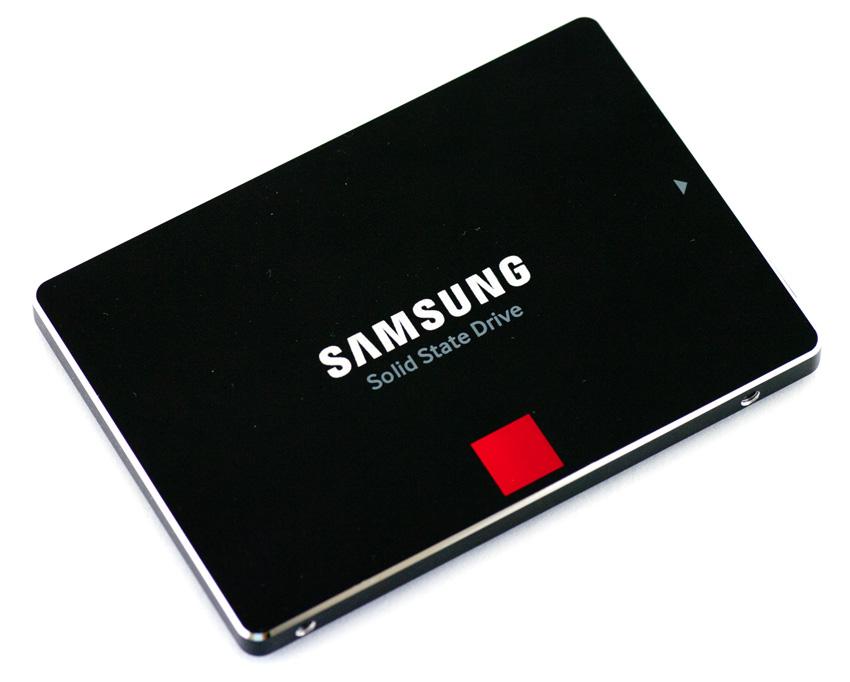
Samsung SSD 850 Pro, combining the new MJX controller and 64-layer MLC 3D V-NAND, is one of the best products in the SATA SSD segment.
Compared to a hard drive, SSDs demonstrate a higher data transfer speed and storage density, better reliability, significantly less latency and access time. For most users, what matters most is the speed of the SSD with which they can read and write data.
Since SSDs do not have moving parts, they can operate at speeds well above the speed of a regular hard drive. And data fragmentation is not a problem for SSDs. Unlike HDD, it does not affect the speed of SSD. From constant use, both SSDs and hard drives end up wearing out, despite the different physical recording methods. SSDs have mechanisms to minimize this effect, such as the TRIM command. Flash data is written in blocks, which requires the prior erasure of existing block data. If there is an empty block, the write operation is much faster. The TRIM command, which should be supported in both the OS and the SSD, allows the operating system to tell the drive which blocks are no longer needed. This allows him to erase data blocks in advance,
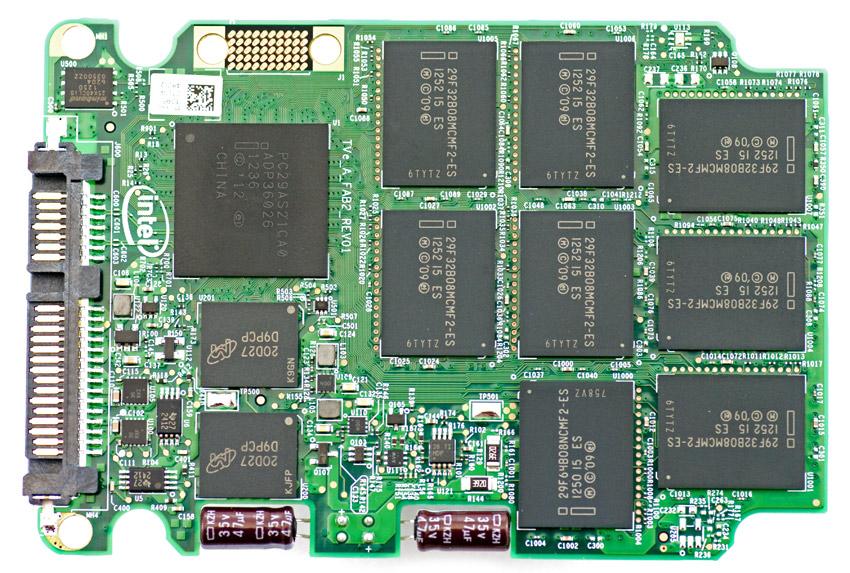
Circuit Board SSD.
In general, SSDs are considered much more reliable than hard drives due to the lack of mechanical parts. Moving HDD mechanisms not only wear out over time, but are also vulnerable to mechanical stress. If you drop a laptop with a hard drive, then there is a high probability of data loss and even fatal physical damage that can completely disable the hard drive. SSDs do not have moving parts, so they can withstand the harsh environment of portable devices.
What are the best uses for SSDs?
Consider the main differences between hard drives and solid state drives:
You can also compare the "standard" SSD and enterprise-class HDD:
An important role is played by drive interfaces:
Many leading drive manufacturers are using PCIe as the standard for new consumer and enterprise storage and some peripherals. The PCIe interface is used in data centers, in RAID-systems, increasing overall performance and supporting new and more capacious hard drives.
SAS and SATA interfaces were developed for the HDD, so they are not optimal for connecting flash drives. The preferred interface for the latter is the combination of PCIe bus with NVMe. PCIe implements the physical interface, while NVMe implements the flash memory management protocol.
SATA significantly limits the bandwidth and adds additional delays, therefore, in modern products, vendors are switching to NVMe and are gradually abandoning the further development of SATA lines. However, SATA drives still have a large capacity and compete with the HDD in tasks where you need to store large amounts of data.

IDC predicts a noticeable decline in the share of SATA flash drives in units of production.
NVMe provides high-performance flash drives inside servers. As for external storage systems, NVMe over Fabric helps to overcome bottlenecks in the storage network - transmitting NVMe commands via Ethernet, Infiniband and Fiber Channel networks.
3D NAND Flash Technology (V-NAND) allows you to overcome the limitations of a "flat" layout by placing cells one above the other. In addition, instead of traditional MOSFETs with a floating gate, it uses flash memory with charge capture (Charge Trap Flash, CTF).
In 2015, Intel and Micron announced 3D XPoint memory. It has more performance and durability than NAND, and is intermediate between DRAM and NAND. This type of phase-transition memory (PCM) is expected to reduce costs by replacing part of the RAM, as well as increasing the performance of NAND SSDs.
3D XPoint technology provides up to 10 times greater performance compared to the "normal" NAND and up to 1000 times longer - withstands more than a million recording cycles. The low latency of 3D XPoint (a thousand times less than that of NAND drives) allows it to be used for tasks with high I / O load, for example, in transaction processing systems. The latest versions of 3D NAND contain up to 72 layers of memory, and manufacturers are already designing products with more than 96 layers.
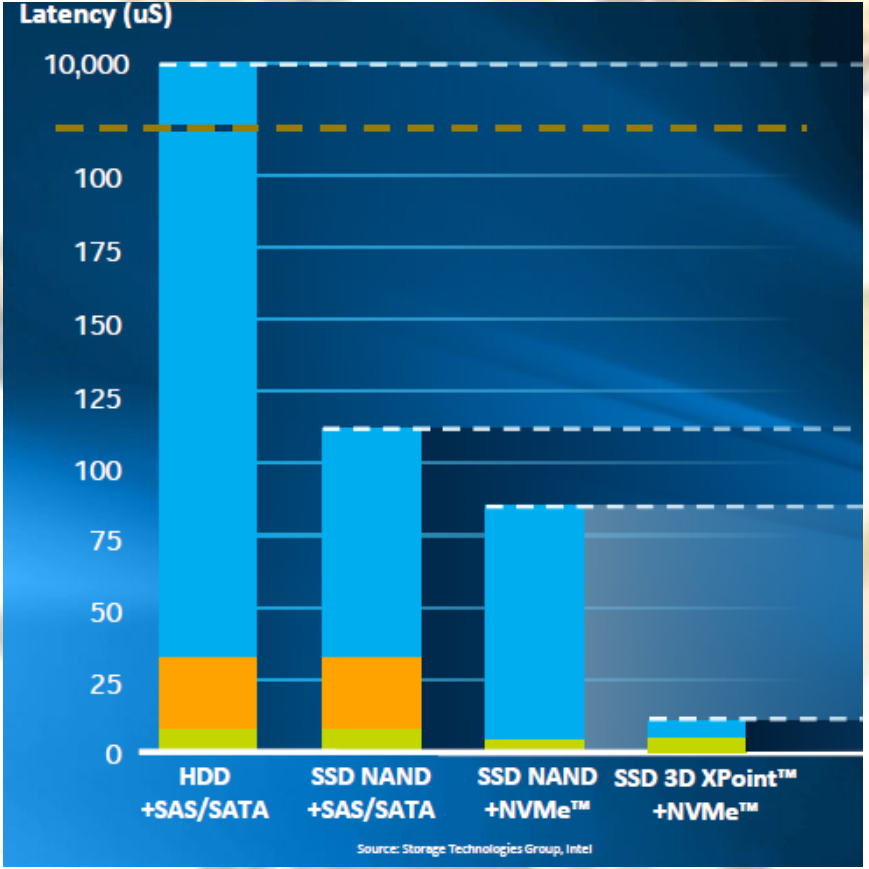
The combination of different types of drives and the resulting delay in milliseconds (according to Intel).
In addition, it is expected that 3-bit NAND cells (TLCs) will be replaced with 4-bit (QLCs). This will increase the memory density and reduce its cost. Last year, Toshiba announced the creation of a BiCS FLASH flash memory capable of storing four bits (QLC) in a single cell, which increased capacity compared to TLC NAND memory. In such a chip with a volumetric layout, there are 64 layers of QLC NAND cells. 16 QLC 3D NAND chips in one enclosure provide a 1.5 TB drive.
The use of SSDs for “hot” and HDDs for “cold” data in combination with mechanisms for their automatic movement through storage levels (tearing) increases the efficiency of IT infrastructure in the data center. You can use caching to speed up access to data, which affects the overall performance of the system. With a large number of drives, the use of SSDs in the data center significantly reduces the cost of electricity.
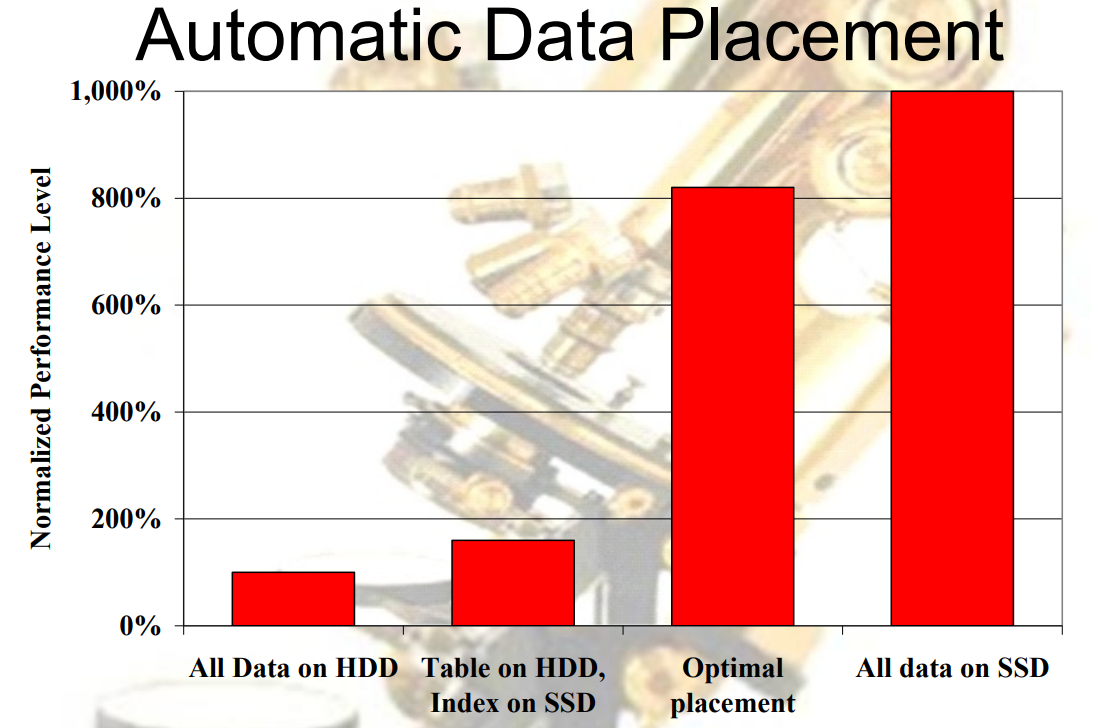
SSDs complement HDDs and optimize storage performance / cost when using automatic data allocation algorithms (source: IBM). On the right, normalized performance is shown, at the bottom - data placement options (from "all on HDD" to "all on SSD").
With the rapidly growing volumes of data, cloud storage is a good way out. The use of SSDs in them allows the provider to guarantee SLA in IOPS.
SSD hosting is gaining popularity - virtual hosting using an array of solid-state drives. VPS are created on high-performance hardware RAID-10 arrays of fast SSDs.
Hosting servers typically use high performance SSDs, data protection, and a large rewrite resource. This allows you to triple the speed of reading / writing, reading blocks of 512 KB is 10 times, and blocks of 4 KB is 50 times faster, the performance in IOPS increases 400 times. The maximum speed and performance of SSD is shown for hosting online stores and other sites using databases.
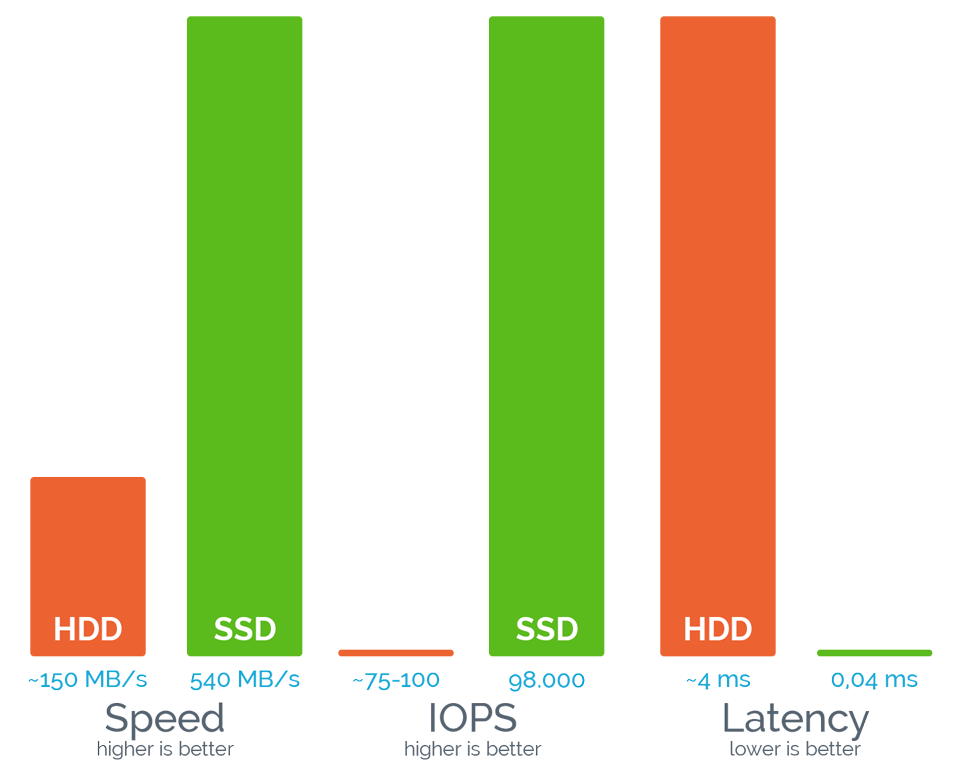
Hosting on SSD and HDD: speed, performance in IOPS, delay.
Solid state drives make websites fly. High speed will be appreciated by both users and search engines. The latter take into account the page load parameters in their ratings.
In the coming years, HDDs will remain the most economical storage solution. By 2020, their capacity can grow 10–20 times. But if progress in the development of SSDs continues at the same pace, then in a few years hard drives will have to face stiff competition, especially if prices for SSDs drop significantly.
Solid state memory will find a place in data centers. Transaction growth, cloud computing, big data analytics, and next-generation workloads will require higher performance. SSDs will be used for storing streaming data, batch processing, for analytics tasks, database management systems and in many other applications, replacing the HDD.
Servers and storage systems with SSD flash drives allow you to solve the most demanding tasks, such as searching in large databases, online transaction processing, business analytics, big data processing and large-scale virtualization. SSDs have every chance of significantly crowding out HDDs in servers and storage systems, becoming a key component of hyperconverged systems. By 2020, a 40TB flash drive may appear, the problem of SSD durability has been practically solved.

Erasing and writing to NAND flash memory leads to its gradual degradation at the level of individual cells, but if NAND consumer drives are designed for 3000-10000 write operations, then modern enterprise-class flash drives can withstand up to 100,000 cycles.
Flash memory helps you work with data more efficiently and store it. SSDs are increasingly being used to store not only “hot”, but also “cold” data.
From the history of hard drives
Hard drives have been around for more than 60 years since IBM first introduced them in 1956. The first disk was huge and could store only 3.75 megabytes, and cost 300,000 dollars in terms of today's exchange rate.

1956 IBM 350 Disk Storage System The
350 Disk Storage System was the primary component of the IBM 305 RAMAC (Random Access Method of Accounting and Control). It consisted of 40 plates and a double read / write head, which moved up and down the stack of magnetic disks.
Since then, the main mechanism of the hard drive, its design has remained unchanged, although it has undergone significant revision. HDD uses the principle of magnetization to store data on a rotating disk. The read / write head “floats” above the magnetic surface of the disc. The higher the rotation speed, the faster the hard drive can work. Typical household HDDs today run at 5400 or 7200 rpm, and some server drives have even higher speeds of 10-15K rpm.

HDD Components HDD
plates are magnetically sensitive, and data is recorded when the magnetic head moves over the surface of a rotating disk. It quickly inverts the magnetization of magnetic domains, changing it to 1 or 0 in binary code. The main and perhaps the only advantage of the hard drive today is that it provides inexpensive storage of a large amount of data - 10-12 TB per disk.
The recording density and HDD rotation speed continue to grow. And if you compare the prices of ordinary hard drives and SSDs, then for solid state drives the cost of storing a data unit is about 3-5 times higher. Therefore, conventional hard drives remain the most economical way to store. According to IDC, today they account for more than 90% of the supply of enterprise-class drives, but by 2025 SSDs will make up almost 20% of the supply.

IDC forecast: how the ratio of HDD and SSD in the supply of corporate drives will change.
What are the best hard drive usage scenarios?
- Disk arrays (NAS, RAID, etc.) where large capacity is required.
- Desktop computers when priority is low cost.
- Storage of media files (photo, video, audio).
- Storage of backup copies and archive data.
In almost all other tasks, the advantage is in flash memory.
What is an SSD?
In fact, SSDs also have a long history. The first semiconductor memory device compatible with the hard disk interface appeared back in 1978. This is StorageTek 4305.

Storage Technology 4305 - 45 MB SSD sample of 1978.
StorageTek was designed for IBM mainframes. The STC 4305 was seven times faster than the then popular IBM 2305 hard drive system. This cabinet cost $ 400,000 and had a bandwidth of up to 1.5 MB / s.
Modern SSDs use non-volatile NAND memory (from the boolean operator “NOT AND”). Flash memory stores data in separate memory cells based on transistors. This semiconductor memory stores data even when there is no power, like the HDD.

Samsung SSD 850 Pro, combining the new MJX controller and 64-layer MLC 3D V-NAND, is one of the best products in the SATA SSD segment.
Compared to a hard drive, SSDs demonstrate a higher data transfer speed and storage density, better reliability, significantly less latency and access time. For most users, what matters most is the speed of the SSD with which they can read and write data.
Since SSDs do not have moving parts, they can operate at speeds well above the speed of a regular hard drive. And data fragmentation is not a problem for SSDs. Unlike HDD, it does not affect the speed of SSD. From constant use, both SSDs and hard drives end up wearing out, despite the different physical recording methods. SSDs have mechanisms to minimize this effect, such as the TRIM command. Flash data is written in blocks, which requires the prior erasure of existing block data. If there is an empty block, the write operation is much faster. The TRIM command, which should be supported in both the OS and the SSD, allows the operating system to tell the drive which blocks are no longer needed. This allows him to erase data blocks in advance,

Circuit Board SSD.
In general, SSDs are considered much more reliable than hard drives due to the lack of mechanical parts. Moving HDD mechanisms not only wear out over time, but are also vulnerable to mechanical stress. If you drop a laptop with a hard drive, then there is a high probability of data loss and even fatal physical damage that can completely disable the hard drive. SSDs do not have moving parts, so they can withstand the harsh environment of portable devices.
What are the best uses for SSDs?
- Laptops and other portable devices where features such as light weight, tight storage density, shock resistance and overall durability are desirable.
- Boot disks containing the operating system and applications, which will speed up the loading and launching of applications.
- Storage of editable work files.
- Cache memory.
- Database Server Repositories.
- Upgrade the old system. Replacing a boot disk with an SSD.
SSD vs HDD
Consider the main differences between hard drives and solid state drives:
| HDD | SSD | |
|---|---|---|
| Cost | $ 0.03 / GB (for 4 TB models) | $ 0.20 - $ 0.30 / GB (for 1 TB models) |
| Capacity | Typically 0.5-2 TB for laptops, up to 10 TB for PC | Usually no more than 1 TB for laptops, up to 4 TB for PCs |
| Average OS boot time | 30-40 sec | 8-13 sec |
| Noise | The noise from moving the rod with the heads and the rotation of the disc | No moving parts - no noise |
| Vibration | The rotation of the disc is sometimes accompanied by vibration. | No moving parts - no vibration |
| Heat dissipation | The HDD does not generate much heat, but it heats much more than an SSD without moving parts, consumes more power | Low power consumption and lack of moving parts lead to low heat dissipation |
| MTBF | 1.5 million hours | 2 million hours |
| Write speed when copying files | 50–120 MB / s | In the latest models - 200-550 MB / s |
| Encryption | Some models support full encryption - Full Disk Encryption (FDE) | Some models support full encryption. |
| File open speed | Slower SSD | Up to 30% faster HDD |
| The influence of magnetic fields | Can erase data | SSDs are not affected by magnetic fields |
| Strength | Vulnerability to Physical Shocks | Shock and vibration resistant |
You can also compare the "standard" SSD and enterprise-class HDD:
| Parameter | SSD | HDD SAS 10-15 RPM |
| Access time, ms | 0.1 | 5.5-8 |
| Random Access Performance (IOPS) | 6000 | 400 |
| Reliability (failure rate) | 0.5% | 2-5% |
| Power consumption, W | 2-5 | 6-15 |
| CPU power consumption (average I / O latency) | 1% | 7% |
| Backup (hours) | 6 | 20-24 |
An important role is played by drive interfaces:
| Interface | Description |
| SATA (Serial Advanced Technology Attachment) | A common interface that provides data exchange with HDD and SSD. SATA SSD drives are great for home use: they are usually cheaper, but they work at a lower speed and have a lower write resource. |
| SAS (Serial Attached SCSI) | SAS drives are often used in RAID arrays, servers, and data centers. This type of interface is also suitable for HDD and SSD. SAS has better IOPS performance than SATA, meaning it can read and write data faster. This makes SAS the optimal choice for systems requiring high performance. SAS supports redundancy and is specifically designed for permanent drive environments. |
| PCIe (Peripheral Component Interconnect Express) | High-performance serial bus interface that supports significantly higher data transfer rates compared to SATA or SAS, as more channels are available for data transfer. |
| NVMe (Non-Volatile Memory Express) | Unlike SAS and SATA, the NVMe protocol was originally developed specifically for solid state drives. It is used for high-speed connection of a flash drive via the PCI Express bus. |
| NVMe over Fabric, including NVMe over Ethernet | Allows you to connect servers to storage systems with low latency and thus claims to be Fiber Channel. |
Many leading drive manufacturers are using PCIe as the standard for new consumer and enterprise storage and some peripherals. The PCIe interface is used in data centers, in RAID-systems, increasing overall performance and supporting new and more capacious hard drives.
SAS and SATA interfaces were developed for the HDD, so they are not optimal for connecting flash drives. The preferred interface for the latter is the combination of PCIe bus with NVMe. PCIe implements the physical interface, while NVMe implements the flash memory management protocol.
SATA significantly limits the bandwidth and adds additional delays, therefore, in modern products, vendors are switching to NVMe and are gradually abandoning the further development of SATA lines. However, SATA drives still have a large capacity and compete with the HDD in tasks where you need to store large amounts of data.

IDC predicts a noticeable decline in the share of SATA flash drives in units of production.
NVMe provides high-performance flash drives inside servers. As for external storage systems, NVMe over Fabric helps to overcome bottlenecks in the storage network - transmitting NVMe commands via Ethernet, Infiniband and Fiber Channel networks.
3D Flash Technology
3D NAND Flash Technology (V-NAND) allows you to overcome the limitations of a "flat" layout by placing cells one above the other. In addition, instead of traditional MOSFETs with a floating gate, it uses flash memory with charge capture (Charge Trap Flash, CTF).
In 2015, Intel and Micron announced 3D XPoint memory. It has more performance and durability than NAND, and is intermediate between DRAM and NAND. This type of phase-transition memory (PCM) is expected to reduce costs by replacing part of the RAM, as well as increasing the performance of NAND SSDs.
3D XPoint technology provides up to 10 times greater performance compared to the "normal" NAND and up to 1000 times longer - withstands more than a million recording cycles. The low latency of 3D XPoint (a thousand times less than that of NAND drives) allows it to be used for tasks with high I / O load, for example, in transaction processing systems. The latest versions of 3D NAND contain up to 72 layers of memory, and manufacturers are already designing products with more than 96 layers.

The combination of different types of drives and the resulting delay in milliseconds (according to Intel).
In addition, it is expected that 3-bit NAND cells (TLCs) will be replaced with 4-bit (QLCs). This will increase the memory density and reduce its cost. Last year, Toshiba announced the creation of a BiCS FLASH flash memory capable of storing four bits (QLC) in a single cell, which increased capacity compared to TLC NAND memory. In such a chip with a volumetric layout, there are 64 layers of QLC NAND cells. 16 QLC 3D NAND chips in one enclosure provide a 1.5 TB drive.
SSD + HDD
The use of SSDs for “hot” and HDDs for “cold” data in combination with mechanisms for their automatic movement through storage levels (tearing) increases the efficiency of IT infrastructure in the data center. You can use caching to speed up access to data, which affects the overall performance of the system. With a large number of drives, the use of SSDs in the data center significantly reduces the cost of electricity.

SSDs complement HDDs and optimize storage performance / cost when using automatic data allocation algorithms (source: IBM). On the right, normalized performance is shown, at the bottom - data placement options (from "all on HDD" to "all on SSD").
SSD hosting
With the rapidly growing volumes of data, cloud storage is a good way out. The use of SSDs in them allows the provider to guarantee SLA in IOPS.
SSD hosting is gaining popularity - virtual hosting using an array of solid-state drives. VPS are created on high-performance hardware RAID-10 arrays of fast SSDs.
Hosting servers typically use high performance SSDs, data protection, and a large rewrite resource. This allows you to triple the speed of reading / writing, reading blocks of 512 KB is 10 times, and blocks of 4 KB is 50 times faster, the performance in IOPS increases 400 times. The maximum speed and performance of SSD is shown for hosting online stores and other sites using databases.

Hosting on SSD and HDD: speed, performance in IOPS, delay.
Solid state drives make websites fly. High speed will be appreciated by both users and search engines. The latter take into account the page load parameters in their ratings.
In the coming years, HDDs will remain the most economical storage solution. By 2020, their capacity can grow 10–20 times. But if progress in the development of SSDs continues at the same pace, then in a few years hard drives will have to face stiff competition, especially if prices for SSDs drop significantly.
Solid state memory will find a place in data centers. Transaction growth, cloud computing, big data analytics, and next-generation workloads will require higher performance. SSDs will be used for storing streaming data, batch processing, for analytics tasks, database management systems and in many other applications, replacing the HDD.
